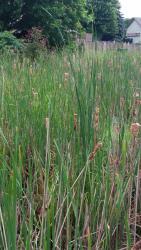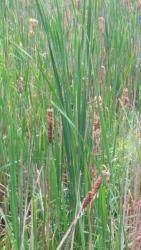I have a natural 'pond' in my yard.. maybe bog? Who knows. It dries out at times in the summer so not really a pond. It is filled with cattails although these cattails seem smaller and mature much slower than the ones in the pond near my work. The ones at work are already done with pollen season while the ones at my home haven't even made visible 'tails' yet. Also, the roots at my house tend to make a gross rusty orange type of 'flour' if I try to harvest the roots so I don't even try anymore - afraid they are contaminated with something. We have a LOT of natural iron in the sand around here, anyone with a well system for their sprinklers has a red line on anything the sprinklers touch. I suspect it is related to that.
Anyway, any idea on the type here? There was a single much MUCH larger one in the pond which I took a picture of too, you can see the tail almost coming out on that one.
Thanks!



